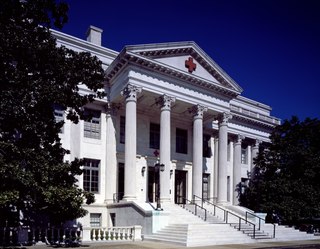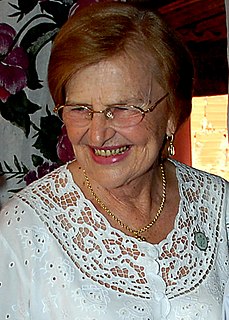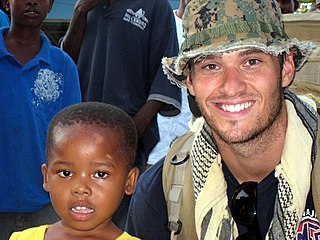Related Research Articles

The Federal Emergency Management Agency (FEMA) is an agency of the United States Department of Homeland Security (DHS), initially created under President Jimmy Carter by Presidential Reorganization Plan No. 3 of 1978 and implemented by two Executive Orders on April 1, 1979. The agency's primary purpose is to coordinate the response to a disaster that has occurred in the United States and that overwhelms the resources of local and state authorities. The governor of the state in which the disaster occurs must declare a state of emergency and formally request from the President that FEMA and the federal government respond to the disaster. The only exception to the state's gubernatorial declaration requirement occurs when an emergency or disaster takes place on federal property or to a federal asset—for example, the 1995 bombing of the Alfred P. Murrah Federal Building in Oklahoma City, Oklahoma, or the Space Shuttle Columbia in the 2003 return-flight disaster.

Mennonite Central Committee (MCC) is a relief service, and peace agency representing fifteen Mennonite, Brethren in Christ and Amish bodies in North America. The U.S. headquarters are in Akron, Pennsylvania, the Canadian in Winnipeg, Manitoba.

Emergency management, also called emergency response or disaster management, is the organization and management of the resources and responsibilities for dealing with all humanitarian aspects of emergencies. The aim is to prevent and reduce the harmful effects of all hazards, including disasters.

Disaster response is the second phase of the disaster management cycle. It consists of a number of elements, for example; warning/evacuation, search and rescue, providing immediate assistance, assessing damage, continuing assistance and the immediate restoration or construction of infrastructure. The aim of emergency response is to provide immediate assistance to maintain life, improve health and support the morale of the affected population. Such assistance may range from providing specific but limited aid, such as assisting refugees with transport, temporary shelter, and food to establishing semi-permanent settlements in camps and other locations. It also may involve initial repairs to damaged or diversion to infrastructure.
Many countries and international organizations offered the United States relief aid in the wake of Hurricane Katrina.

The disaster recovery response to Hurricane Katrina included federal government agencies such as the Federal Emergency Management Agency (FEMA), the United States Coast Guard (USCG), state and local-level agencies, federal and National Guard soldiers, non-governmental organizations, charities, and private individuals. Tens of thousands of volunteers and troops responded or were deployed to the disaster; most in the affected area but also throughout the U.S. at shelters set up in at least 19 states.

The Robert T. Stafford Disaster Relief and Emergency Assistance Act is a 1988 United States federal law designed to bring an orderly and systematic means of federal natural disaster assistance for state and local governments in carrying out their responsibilities to aid citizens. Congress' intention was to encourage states and localities to develop comprehensive disaster preparedness plans, prepare for better intergovernmental coordination in the face of a disaster, encourage the use of insurance coverage, and provide federal assistance programs for losses due to a disaster.

In times of crisis and natural disasters, amateur radio is often used as a means of emergency communication when wireline, cell phones and other conventional means of communications fail.

The American Red Cross (ARC), also known as The American National Red Cross, is a non-profit humanitarian organization that provides emergency assistance, disaster relief, and disaster preparedness education in the United States. It is the designated US affiliate of the International Federation of Red Cross and Red Crescent Societies and the United States movement to the International Red Cross and Red Crescent Movement.
The Massachusetts Emergency Management Agency (MEMA) is a Commonwealth of Massachusetts agency. The Massachusetts Emergency Management Agency is the Agency that coordinates federal, state, local, and private resources throughout the Commonwealth during times of disasters and emergencies.
Citizen Corps is a program under the Department of Homeland Security that provides training for the population of the United States to assist in the recovery after a disaster or terrorist attack. Each local Citizen Corps Council partners with organizations, volunteers and businesses to organize responders, volunteers and professional first responders for an efficient response so efforts are not wasted by being duplicated. By training in Incident Command, volunteers know whom to report to and how the incident is organized. This prevents sites from being inundated by untrained and unprepared personnel preventing operation. Citizen Corps also works in conjunction with the Corporation for National and Community Service in promoting national service opportunities for promoting homeland security needs.
Katrina Aid Today is a relief charity in the United States, that works to provide long term recovery support to survivors of Hurricane Katrina. United Methodist Committee on Relief (UMCOR), the humanitarian relief and development agency of the United Methodist Church, manages the U.S. Department of Homeland Security's Federal Emergency Management Agency (FEMA) sponsored program. Nine national partners and sixteen local organizations, who specialize in availability of benefits, resources and services, aim to deliver assistance to 300,000 of the most vulnerable survivors in the United States.

The Oklahoma Department of Emergency Management (OEM) is a department of the government of Oklahoma responsible for coordinating the response to a natural disaster that has occurred in the State and that has overwhelmed the abilities of local authorities. This is achieved primarily through the development and maintenance of a comprehensive statewide emergency management plan. OEM is responsible for coordinating the efforts of the federal government with other state departments and agencies, county and municipal governments and school boards, and with private agencies that have a role in emergency management.
VOAD means one or coalition of Second Responder organizations in the United States. These groups voluntarily help survivors after a disaster. VOAD members cannot activate, direct, or supervise one another without a special agreement. The term "VOAD" is ambiguous, with at least five meanings:
- VOAD Movement
- VOAD Chapters
- Informal VOAD Networks
- VOAD Member Organizations
- Any Voluntary Organization(s) Active in a Disaster
Islamic Relief USA (IRUSA), based in Alexandria, Virginia, is a non-profit 501(c)(3) humanitarian agency and member of the Islamic Relief Worldwide group of organizations. IRUSA was founded in California in 1993. In addition to international relief and development initiatives, Islamic Relief USA also sponsors and funds domestic projects ranging from emergency disaster responses to assisting the American homeless population and supporting those who cannot afford basic healthcare.

The humanitarian responses by non-governmental organizations to the 2010 Haiti earthquake included many organisations, such as international, religious, and regionally based NGOs, which immediately pledged support in the aftermath of the 2010 Haiti earthquake. Besides a large multi-contingency contribution by national governments, NGOs contributed significantly to both on-the-ground rescue efforts and external solicitation of aid for the rescue efforts.

Team Rubicon is an international non-government organization (NGO) specializing in disaster response.
Lakeshore Area Regional Recovery of Indiana, or LARRI, is a committee of non-profit, faith-based, business, public and other community partners that are commonly known as a long-term recovery committee. LARRI was formed to serve the survivors of the flooding of September 13–15, 2008 who have reasonably exhausted their resources from insurance, FEMA, savings and other sources in the restoration of their homes.

All Hands and Hearts (AHAH) is a U.S. 501(c)3 nonprofit organization. The organization's current structure formed in late 2017, when two existing nonprofits, All Hands Volunteers and Happy Hearts Fund merged to become All Hands and Hearts. All Hands Volunteers was founded in September 2005 by philanthropist and businessman David Campbell to provide relief to residents in areas affected by natural disasters worldwide. Happy Hearts Fund, founded by philanthropist and supermodel, Petra Němcová, sought a similar goal, to help communities recover after a disaster event. All Hands and Hearts is based in Mattapoisett, Massachusetts.
References
- ↑ "History". www.nvoad.org. Retrieved 2017-03-03.
- ↑ V. Alex Kehayan (2005). Resiliency in the Face of Disaster and Terrorism . pp. 140. ISBN 1-932181-18-0.
- ↑ "National Voluntary Organizations Active in Disaster" (PDF). United States Senate. March 1, 2006. Archived from the original (PDF) on September 21, 2008.
- ↑ Mary C. Comerio (1998). Disaster Hits Home. p. 264. ISBN 0-520-20780-7.
- ↑ "National Response Plan" (PDF). Department of Homeland Security. December 2004.
- ↑ "Latter-day Saint Charities".
- ↑ "Team Rubicon | Built to Serve".